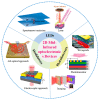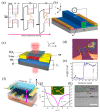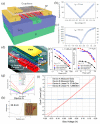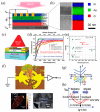Mid-Infrared Optoelectronic Devices Based on Two-Dimensional Materials beyond Graphene: Status and Trends
- PMID: 35808105
- PMCID: PMC9268368
- DOI: 10.3390/nano12132260
Mid-Infrared Optoelectronic Devices Based on Two-Dimensional Materials beyond Graphene: Status and Trends
Abstract
Since atomically thin two-dimensional (2D) graphene was successfully synthesized in 2004, it has garnered considerable interest due to its advanced properties. However, the weak optical absorption and zero bandgap strictly limit its further development in optoelectronic applications. In this regard, other 2D materials, including black phosphorus (BP), transition metal dichalcogenides (TMDCs), 2D Te nanoflakes, and so forth, possess advantage properties, such as tunable bandgap, high carrier mobility, ultra-broadband optical absorption, and response, enable 2D materials to hold great potential for next-generation optoelectronic devices, in particular, mid-infrared (MIR) band, which has attracted much attention due to its intensive applications, such as target acquisition, remote sensing, optical communication, and night vision. Motivated by this, this article will focus on the recent progress of semiconducting 2D materials in MIR optoelectronic devices that present a suitable category of 2D materials for light emission devices, modulators, and photodetectors in the MIR band. The challenges encountered and prospects are summarized at the end. We believe that milestone investigations of 2D materials beyond graphene-based MIR optoelectronic devices will emerge soon, and their positive contribution to the nano device commercialization is highly expected.
Keywords: mid-infrared; modulator; photodetectors; two-dimensional materials.
Conflict of interest statement
The authors declare no conflict of interest.
Figures






























Similar articles
-
Infrared Light Emission Devices Based on Two-Dimensional Materials.Nanomaterials (Basel). 2022 Aug 30;12(17):2996. doi: 10.3390/nano12172996. Nanomaterials (Basel). 2022. PMID: 36080035 Free PMC article. Review.
-
2D materials beyond graphene toward Si integrated infrared optoelectronic devices.Nanoscale. 2020 Jun 14;12(22):11784-11807. doi: 10.1039/d0nr02574g. Epub 2020 May 28. Nanoscale. 2020. PMID: 32462161
-
Two-Dimensional Tellurium: Progress, Challenges, and Prospects.Nanomicro Lett. 2020 Apr 21;12(1):99. doi: 10.1007/s40820-020-00427-z. Nanomicro Lett. 2020. PMID: 34138088 Free PMC article. Review.
-
Research Process on Photodetectors based on Group-10 Transition Metal Dichalcogenides.Small. 2023 Apr;19(16):e2207641. doi: 10.1002/smll.202207641. Epub 2023 Jan 19. Small. 2023. PMID: 36658722 Review.
-
Two-Dimensional Materials for Integrated Photonics: Recent Advances and Future Challenges.Small Sci. 2021 Feb 19;1(4):2000053. doi: 10.1002/smsc.202000053. eCollection 2021 Apr. Small Sci. 2021. PMID: 40213355 Free PMC article.
Cited by
-
Mid-Infrared Photonic Sensors: Exploring Fundamentals, Advanced Materials, and Cutting-Edge Applications.Sensors (Basel). 2025 Feb 12;25(4):1102. doi: 10.3390/s25041102. Sensors (Basel). 2025. PMID: 40006331 Free PMC article. Review.
-
Evolution of the Electronic Properties of Tellurium Crystals with Plasma Irradiation Treatment.Nanomaterials (Basel). 2024 Apr 25;14(9):750. doi: 10.3390/nano14090750. Nanomaterials (Basel). 2024. PMID: 38727344 Free PMC article.
-
Nonlinear saturable absorption properties of BP/ReS2 heterojunction and its application in 2 μm all-solid-state lasers.Front Optoelectron. 2025 Jun 11;18(1):14. doi: 10.1007/s12200-025-00157-3. Front Optoelectron. 2025. PMID: 40498376 Free PMC article.
-
Graphene nanowalls in photodetectors.RSC Adv. 2023 Jul 28;13(33):22838-22862. doi: 10.1039/d3ra03104g. eCollection 2023 Jul 26. RSC Adv. 2023. PMID: 37520101 Free PMC article. Review.
-
Infrared Light Emission Devices Based on Two-Dimensional Materials.Nanomaterials (Basel). 2022 Aug 30;12(17):2996. doi: 10.3390/nano12172996. Nanomaterials (Basel). 2022. PMID: 36080035 Free PMC article. Review.
References
-
- Bonaccorso F., Sun Z., Ferrari T.H.A.C. Graphene photonics and optoelectronics. Nat. Photonics. 2010;4:611–622. doi: 10.1038/nphoton.2010.186. - DOI
-
- Ramasubramaniam A., Naveh D., Towe E. Tunable band gaps in bilayer transition-metal dichalcogenides. Phys. Rev. B. 2011;84:205325. doi: 10.1103/PhysRevB.84.205325. - DOI
Publication types
Grants and funding
LinkOut - more resources
Full Text Sources

